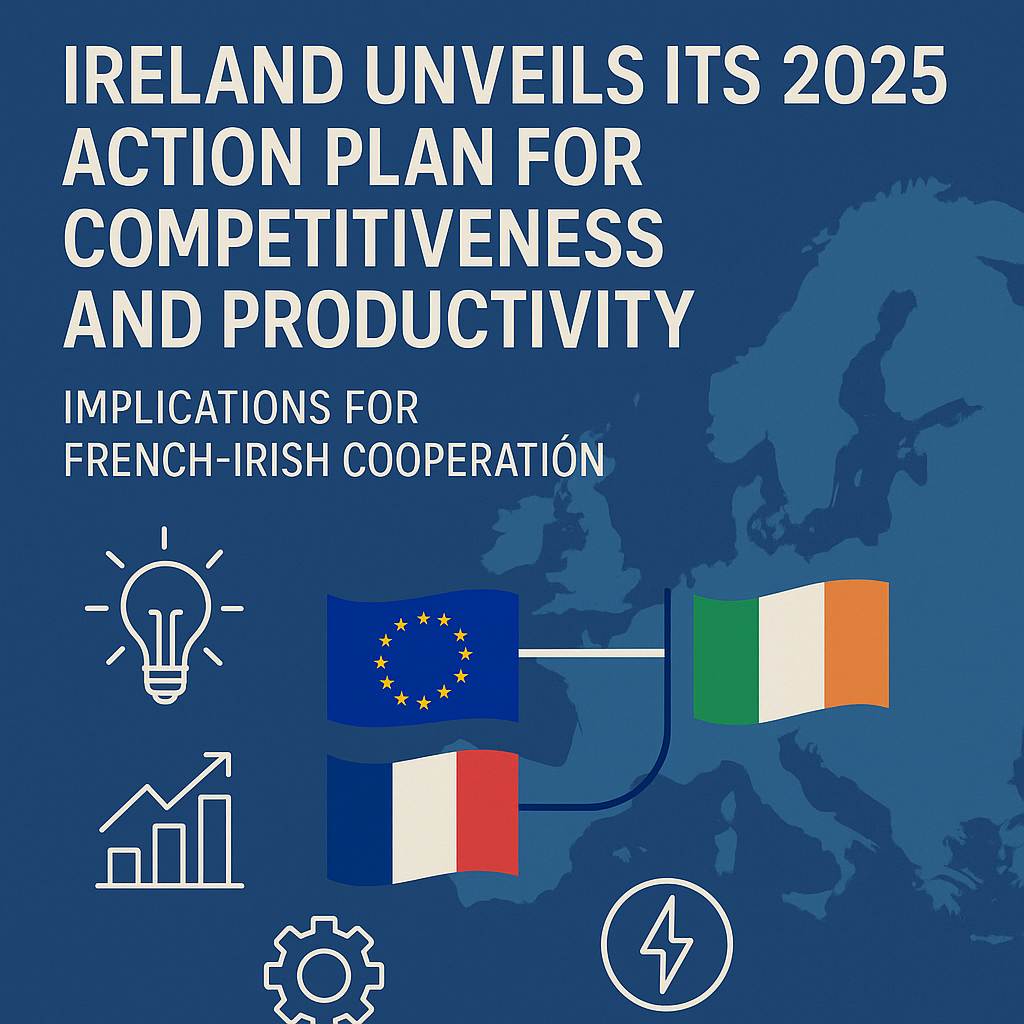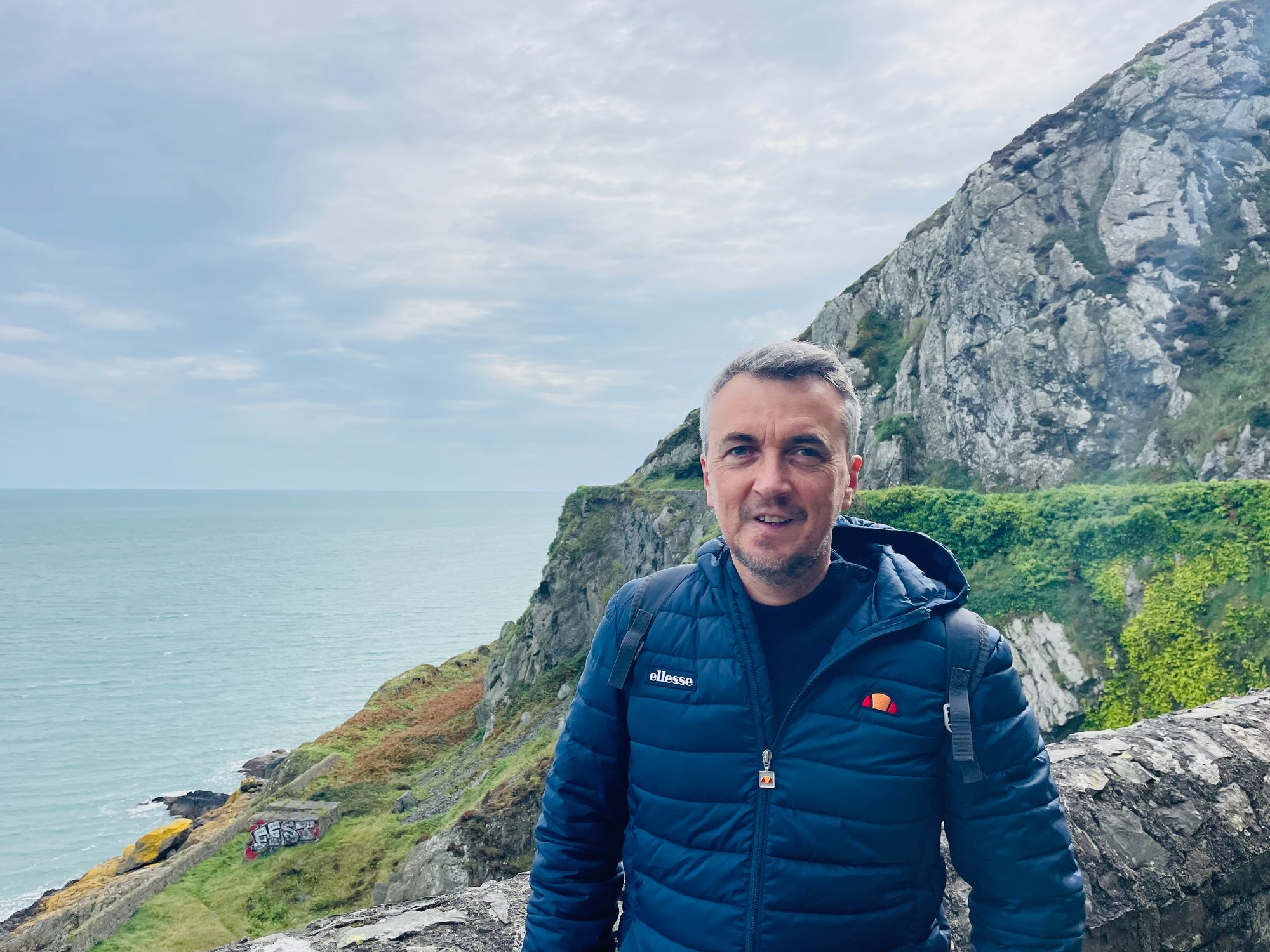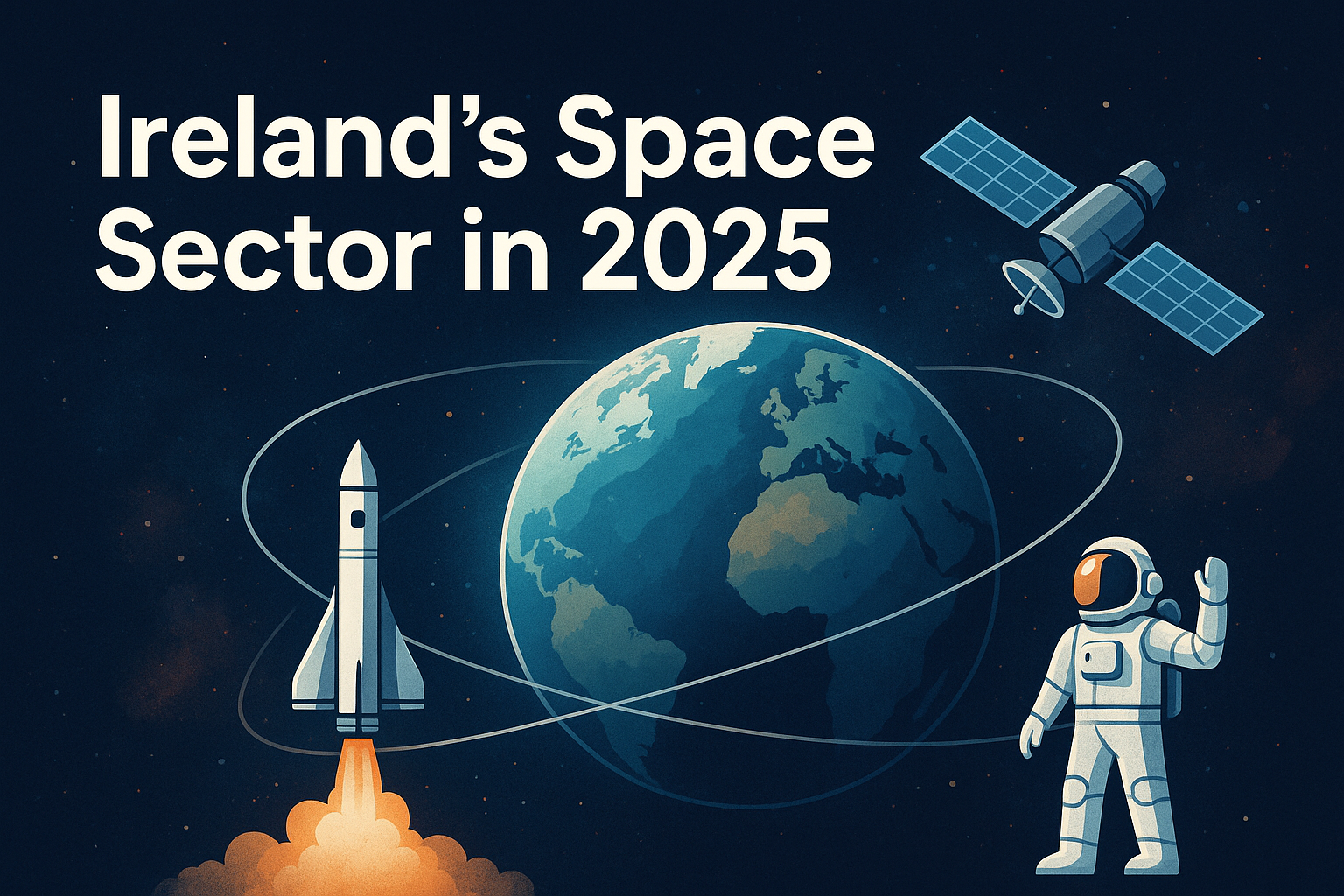Ireland unveils its 2025 Action Plan for Competitiveness and Productivity

Implications for Franco-Irish Cooperation in Europe’s Competitiveness Agenda
In September 2025, the Irish government released its Action Plan on Competitiveness and Productivity, a major strategic document setting out the country’s economic priorities for the coming decade. This plan builds on the National Development Plan (NDP 2025) and draws inspiration from the recommendations of the Draghi report on European competitiveness. It responds to a clear reality: despite remarkable performance, the Irish economy remains vulnerable to certain structural imbalances and to international shocks. The stated objective is clear — to strengthen resilience, consolidate innovation, and ensure inclusive and sustainable growth.
Ranked 7th in the IMD 2025 Global Competitiveness Index, Ireland enjoys undeniable advantages. Yet these results rely heavily on a small number of multinationals and on exceptional, so-called “windfall” tax revenues. High energy and housing costs, strained infrastructure, and a lack of financing for SMEs highlight the need for a proactive strategy. The plan therefore proposes a pragmatic approach: to “control domestic factors”, in other words, to act on the areas directly within the country’s control.
Beyond its national focus, the Action Plan also raises important questions for Ireland’s role within the European Union and its partnerships with key member states. In particular, it opens the door to deeper Franco-Irish cooperation, given the strong complementarities between the two countries in areas such as innovation, digital technologies, energy transition, and industrial competitiveness.
Six Strategic Challenges
The plan identifies six priority areas that will determine Ireland’s future competitiveness:
- Productivity: boosting research, innovation, and skills.
- International openness: attracting investment, diversifying exports, and strengthening influence in Europe.
- SMEs: creating and scaling more local, competitive businesses.
- Regulation: simplifying the administrative environment and containing costs.
- Infrastructure: improving the State’s capacity to deliver efficiently.
- Sustainability and regions: promoting the green transition and regional balance.
Altogether, the plan outlines 85 actions, of which 26 are considered transformative priorities.
1. Productivity: investing in innovation and talent
Although Ireland outperforms the European average, it lags behind the best-performing small advanced economies. To close this gap, the plan proposes a national research infrastructure program to strengthen both basic and applied research, with a special focus on emerging technologies such as AI, quantum computing, and high-performance computing (HPC). The creation of a National Artificial Intelligence Office (NAIO) and a National AI Observatory illustrates the government’s commitment to both regulating the use of these technologies and encouraging their adoption.
A second key pillar is skills development. While Ireland performs well in lifelong learning, it still trails European leaders. The plan therefore calls for the establishment of a National Skills Observatory to anticipate future labor market needs, as well as a review of immigration policies to attract international talent. The goal is to build an agile workforce, able to adapt to digital and green transitions.
2. International openness: diversification and influence
As a highly globalized economy, Ireland is exposed to geopolitical and trade tensions. To bolster resilience, the plan focuses on greater market diversification and stronger engagement in European initiatives. It foresees more active participation in IPCEIs (Important Projects of Common European Interest) — particularly in semiconductors, AI, quantum, and batteries — as well as the creation of Next Generation Sites to host major industrial projects.
At the same time, Ireland intends to strengthen its voice in Brussels. It will advocate for a more integrated Single Market, lower energy costs, and streamlined regulation. This strategy aims not only to reinforce Ireland’s attractiveness but also to contribute to the overall competitiveness of the European Union.
3. SMEs and start-ups: consolidating the ecosystem
SMEs and start-ups are seen as essential to diversifying an economy still dominated by multinationals. The plan calls for the creation of Start-up Ireland, a central coordinating body that will oversee a National Accelerator Programme and align public support measures. The objective is to bring more coherence and visibility to the entrepreneurial ecosystem.
A scaling-up fund for SMEs will also be created, combining public and private capital — including pension funds and national savings. Tax incentives such as KEEP and Entrepreneur Relief will be adapted to help retain teams and support domestic growth. Finally, the plan emphasizes the importance of valorizing university research outputs, through patents, licenses, and spin-offs.
4. Regulation: simplifying and reducing costs
Administrative burdens are widely viewed as a major obstacle. To address this, the government will launch a “Red Tape Challenge”, requiring each ministry to identify regulations that can be simplified or removed without undermining policy goals. A new Economic Regulators’ Forum will enhance coordination among Ireland’s many regulatory bodies.
Judicial reforms are also planned, aimed at speeding up procedures, reducing litigation costs, and integrating digital tools. The Competition and Consumer Protection Commission (CCPC) will be given new powers to sanction anti-competitive practices, enhance transparency, and protect consumers.
5. Infrastructure: massive investment and efficient delivery
The State plans record public investment of €275.4 billion between 2026 and 2035, including over €100 billion in the first five years. These resources will help close gaps in housing, transport, energy, and water. An Accelerating Infrastructure Taskforce will be tasked with identifying and removing regulatory and administrative barriers.
Construction productivity must also improve, through the adoption of Modern Methods of Construction (MMC), digitalization, and more sustainable practices. The government will facilitate the recruitment of specialized expertise into public administration to strengthen project management. Finally, a long-term strategy will be developed to diversify airport infrastructure and reduce dependency on Dublin Airport.
6. Sustainability and regions: turning the green transition into an asset
The ecological transition is presented not as a constraint but as a driver of competitiveness. The plan foresees temporary support for energy-intensive industries, to cushion energy costs and encourage greater use of renewables. The new Private Wire Framework will allow companies to install private networks and connect directly to green energy sources.
Regional development is another key priority, with the launch of pilot clusters and new Regional Enterprise Plans. The tourism sector will receive support for digitalization and sustainable certification. Finally, Ireland is preparing to host new energy-intensive industries — such as data centers, microelectronics, and quantum technologies — ensuring they are integrated into a planning framework aligned with renewable energy resources.
European cooperation and Franco-Irish opportunities
While the Action Plan is first and foremost a national strategy, it also firmly situates Ireland within a European context. Strengthening competitiveness today requires deeper integration into EU initiatives, and in this respect, France — Ireland’s closest neighbor within the Union and a major player in European industrial policy — appears as a natural partner. The complementarities between the two countries create fertile ground for structured cooperation.
1. IPCEIs and strategic technologies
Ireland has expressed its intention to increase participation in Important Projects of Common European Interest (IPCEIs), particularly in semiconductors, artificial intelligence, quantum, and batteries. France is already deeply invested in these areas, mobilizing national champions such as STMicroelectronics, Atos, Airbus, Thales, and strong academic and research institutions. Joint Franco-Irish participation would not only allow Ireland to tap into established expertise but also give France a dynamic, agile partner with strong connections to international markets. Together, the two countries could build cross-border innovation pipelines, ensuring Europe closes its technology gap with the US and Asia.
2. AI Factory and High-Performance Computing (HPC)
Ireland’s ambition to host an AI Factory Antenna under EuroHPC and to develop a comprehensive HPC and quantum strategy opens the door to direct collaboration with French initiatives such as GENCI (Grand Équipement National de Calcul Intensif), Inria, and Station F in Paris. These synergies could lead to joint training programs, shared access to supercomputing infrastructures, and collaborative research projects. A Franco-Irish axis in AI and HPC would position both countries at the forefront of Europe’s digital transformation, ensuring the EU has the computing power and talent base needed for strategic autonomy.
3. Regional clusters and innovation ecosystems
Ireland plans to launch regional pilot clusters to foster collaboration between universities, start-ups, and industry. France has over fifteen years of experience with its Pôles de compétitivité, covering areas such as aerospace, biomedicine, green tech, and digital. Establishing Franco-Irish cluster partnerships could accelerate regional innovation by sharing best practices, linking SMEs across borders, and creating new transnational value chains. For instance, medtech clusters in Galway could be connected to French bioclusters in Lyon, while agri-tech hubs in Ireland could engage with French innovation networks in food and sustainable agriculture.
4. Energy transition and interconnection
Energy is a critical theme in both strategies. Ireland’s plan emphasizes the need to support energy-intensive industries, promote Private Wire Frameworks, and scale up offshore wind. France, meanwhile, is advancing its offshore wind strategy and heavily investing in hydrogen as part of its France 2030 plan. The Celtic Interconnector, the first direct electricity link between France and Ireland, embodies this convergence. Beyond providing grid stability, it could become the backbone for future cooperation in smart grids, hydrogen corridors, and joint R&D projects in renewable energy technologies. This collaboration could help both countries reduce dependence on imported fossil fuels and contribute to Europe’s climate goals.
5. Joint influence within the EU
Finally, cooperation between France and Ireland is not limited to projects; it also extends to policy influence in Brussels. France, as a traditional leader in EU industrial and energy policy, and Ireland, as an agile, outward-looking economy with strong ties to the US and global markets, could combine their strengths to advocate for a more competitive and innovation-driven Europe. Together, they could push for reforms in the Single Market, improved access to EU financing, and a regulatory framework that balances competitiveness with sustainability.
By aligning their strategies, France and Ireland can create a joint platform for European competitiveness, one that leverages France’s industrial depth and Ireland’s entrepreneurial agility. This would strengthen Europe’s ability to innovate, scale, and lead in key sectors while reinforcing its technological and industrial sovereignty.
Towards a Resilient and Sustainable Competitiveness
This Action Plan expresses a strong ambition: not to settle for the European average but to compete with the most advanced economies. It is built on clear governance, rigorous monitoring, and the collective mobilization of the State, businesses, universities, and civil society.
Competitiveness is thus framed not only as an economic challenge but also as a question of resilience and sustainability. By consolidating its strengths and addressing its weaknesses, Ireland aims to position itself as a reference economy in Europe for the decades to come.


